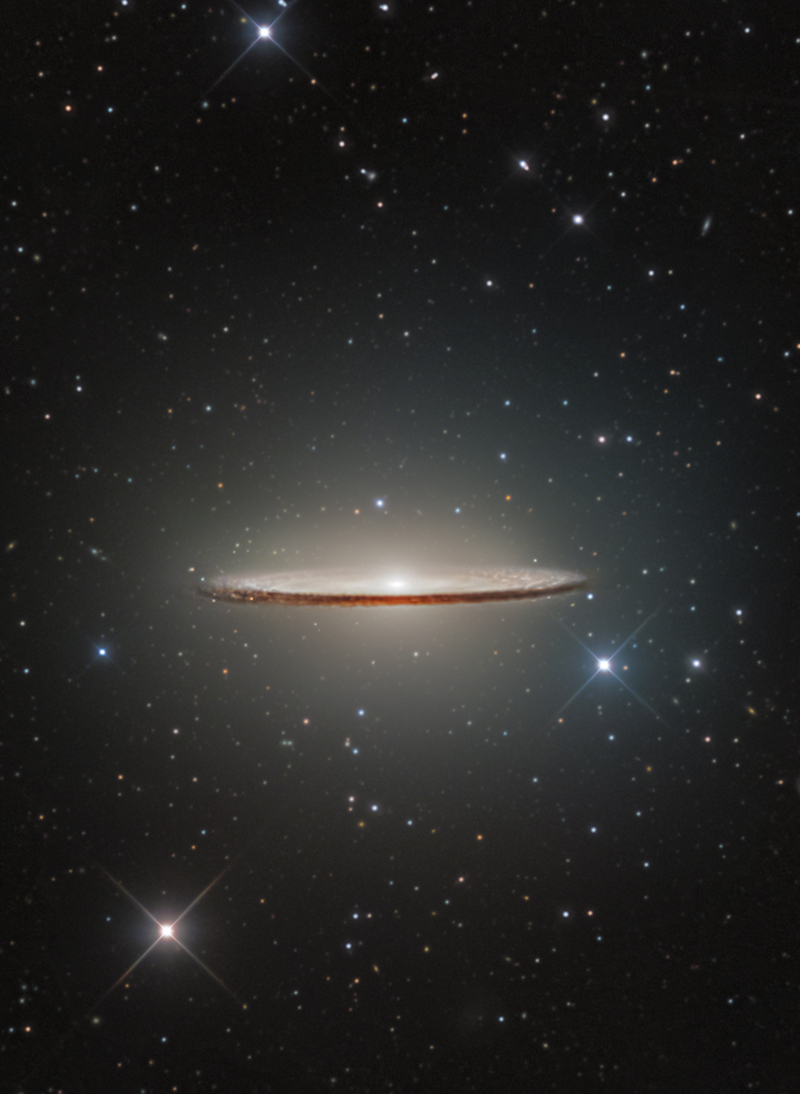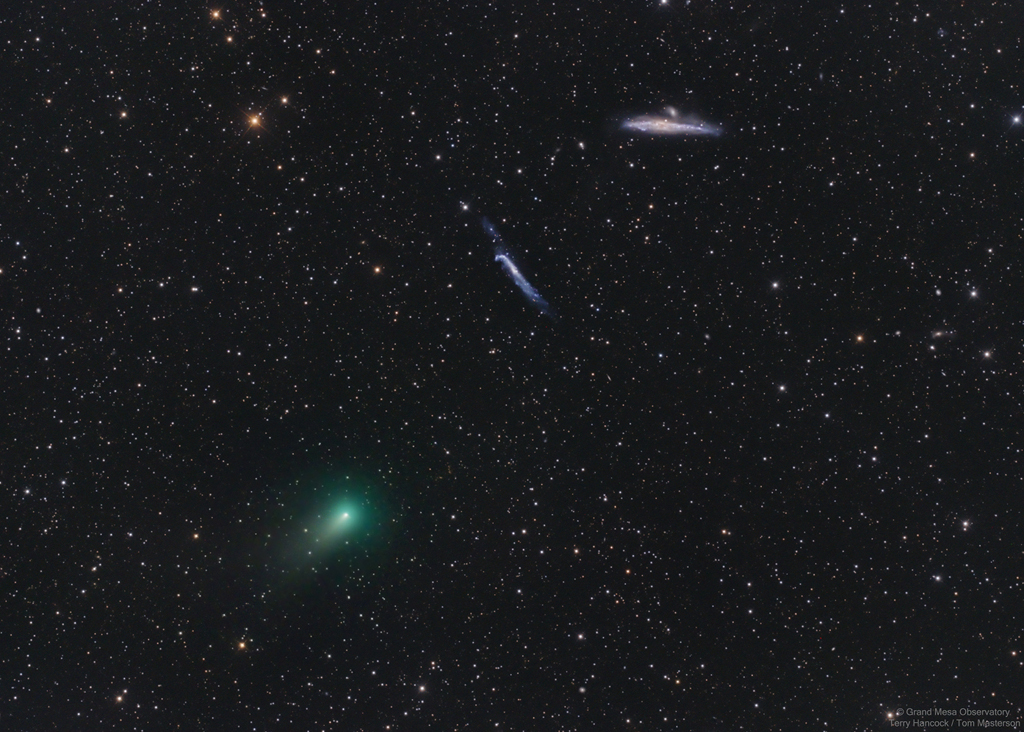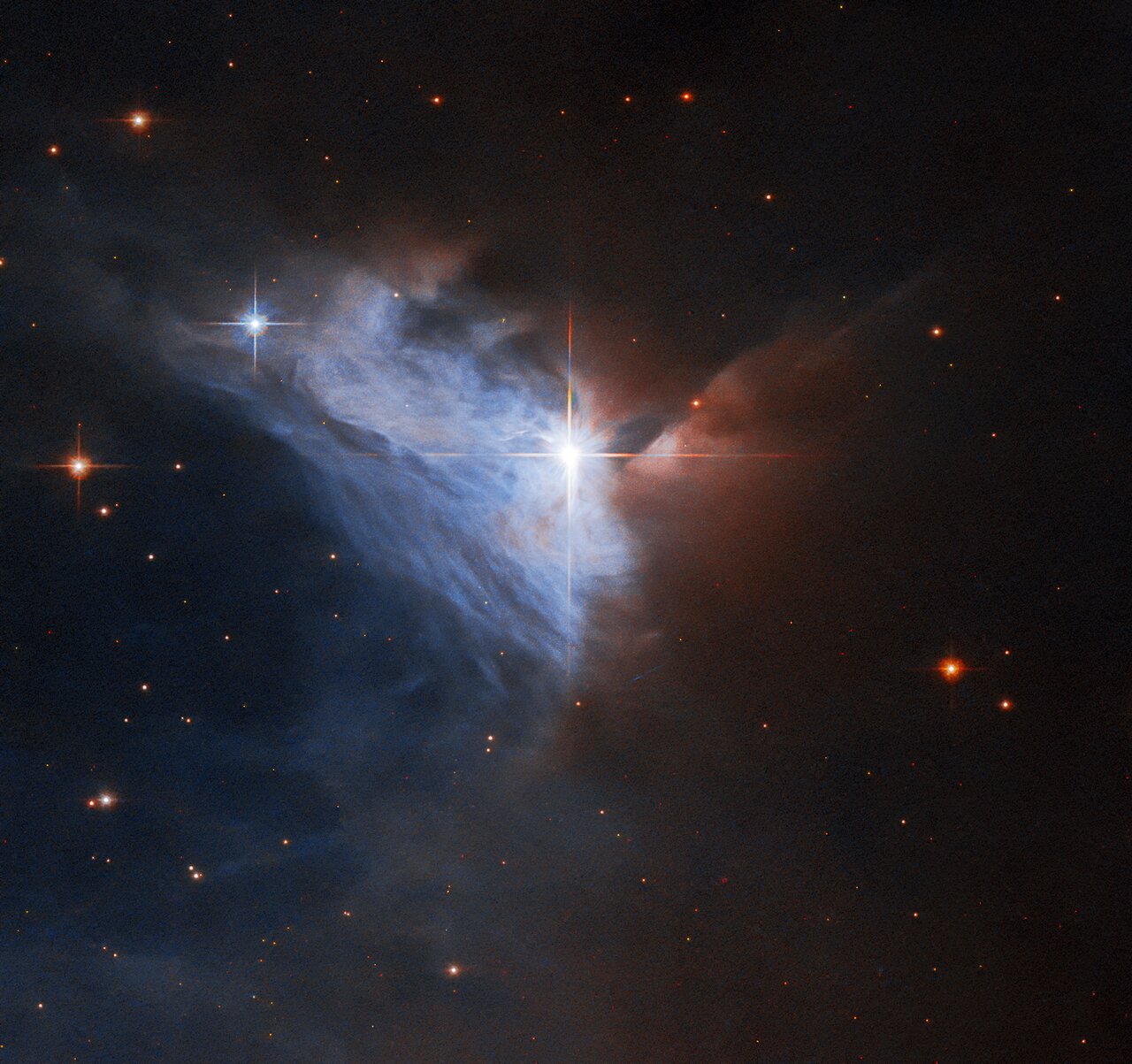Blog
M104 is famous for its nearly edge-on profile featuring a broad ring of obscuring dust lanes. Seen in silhouette against an extensive central bulge of stars, the swath of cosmic dustlends a broad brimmed hat-like appearance to the galaxy suggesting a more popular moniker, the Sombrero Galaxy. This sharp optical view of the well-known galaxy made from ground-based image data was processed to preserve details often lost in overwhelming glare of M104’s bright central bulge. Also known as NGC 4594, the Sombrero galaxy can be seen across the spectrum, and is host to a central supermassive black hole. About 50,000 light-years across and 28 million light-years away, M104 is one of the largest galaxies at the southern edge of the Virgo Galaxy Cluster. Still the colorful spiky foreground stars in this field of view lie well within our own Milky Way galaxy.

David Byrne (/bɜːrn/; born 14 May 1952) is a Scottish-American singer, songwriter, record producer, actor, writer, music theorist, and filmmaker, who was a founding member and the principal songwriter, lead singer, and guitarist of the American new wave band Talking Heads.
Byrne has released solo recordings and worked with various media including film, photography, opera, fiction, and non-fiction. He has received Academy, Grammy, and Golden Globe Awards, and he is an inductee to the Rock and Roll Hall of Fame as part of Talking Heads.
more...John Symon Asher Bruce (14 May 1943 – 25 October 2014) was a Scottish bassist, singer-songwriter, musician and composer. He gained popularity as the co-lead vocalist and bassist of British rock band Cream. After the group disbanded in 1968, he pursued a solo career and also played with several bands.
In the early 1960s Bruce joined the Graham Bond Organisation, where he met his future bandmate Ginger Baker. After leaving the Graham Bond Organisation, he joined with John Mayall & the Bluesbreakers, where he met Eric Clapton, who also was his future bandmate. His time with the band was brief. In 1966, he formed Cream with lead guitarist Clapton and drummer Baker; he co-wrote many of their songs (including “Sunshine of Your Love“, “White Room” and “I Feel Free“) with poet/lyricist Pete Brown. After the group disbanded in the late 1960s he began recording solo albums. His first solo album, Songs for a Tailor, released in 1969, was a worldwide hit. Bruce formed his own band to perform the material live, and subsequently formed a blues-rock band West, Bruce and Laing in 1972, with guitarist Leslie West and drummer Corky Laing. His solo career spanned several decades. From the 1970s to the 1990s he played with several groups as a touring member. He reunited with Cream in 2005 for concerts at the Royal Albert Hall and at Madison Square Garden in New York.
Bruce is considered to be one of the most important and influential bassists of all time. Rolling Stone magazine readers ranked him number eight on their list of “10 Greatest Bassist Of All Time”. He was inducted in the Rock and Roll Hall of Fame in 1993, and was awarded the Grammy Lifetime Achievement Award in 2006, both as a member of Cream.
more...Arthur James “Zutty” Singleton (May 14, 1898 – July 14, 1975) was an American jazz drummer.
Singleton was born in Bunkie, Louisiana, and raised in New Orleans. According to his Jazz Profiles biography, his unusual nickname, acquired in infancy, is the Creole word for “cute”. He was working professionally with Steve Lewis by 1915. He served with the United States Navy in World War I. After returning to New Orleans he worked with Papa Celestin, Big Eye Louis Nelson, John Robichaux, and Fate Marable. He left for St. Louis, Missouri, to play in Charlie Creath‘s band, then moved to Chicago.
In Chicago, Singleton played with Doc Cook, Dave Peyton, Jimmie Noone, and theater bands, then joined Louis Armstrong‘s band with Earl Hines. In 1928 and 1929, he performed on landmark recordings with Louis Armstrong and his Hot Five. In 1929 he moved with Armstrong to New York City.
In addition to Armstrong in New York he played with Bubber Miley, Tommy Ladnier, Fats Waller, Jelly Roll Morton and Otto Hardwick. He also played in the band backing Bill Robinson. In 1934, Singleton returned to Chicago. He returned to New York in 1937, working with Mezz Mezzrow and Sidney Bechet.
In 1943, he moved to Los Angeles, where he led his own band, played for motion pictures, and appeared on the radio program The Orson Welles Almanac (1944). He also worked with Slim Gaillard, Wingy Manone, Eddie Condon, Nappy Lamare, Art Hodes, Oran “Hot Lips” Page, and Max Kaminsky.
more...- salida (entrance)
- paseo (walkaround)
- silencio (similar to an adagio in ballet – it is the singer who is “silent”)
- castellana (upbeat section)
- escobilla (literally “brush” as with a broom, which describes dancers’ footwork in this section)
- bulerias
Closest to the Sun on March 1, and closest to planet Earth on April 23, this Comet ATLAS (C/2020 R4) shows a faint greenish coma and short tail in this pretty, telescopic field of view. Captured at its position on May 5, the comet was within the boundaries of northern constellation Canes Venatici (the Hunting Dogs), and near the line-of-sight to intriguing background galaxies popularly known as the Whale and the Hockey Stick. Cetacean in appearance but Milky Way sized, NGC 4631 is a spiral galaxy seen edge-on at the top right, some 25 million light-years away. NGC 4656/7 sports the bent-stick shape of interacting galaxiesbelow and left of NGC 4631. In fact, the distortions and mingling trails of gas detected at other wavelengths suggest the cosmic Whale and Hockey Stick have had close encounters with each other in their distant past.Outbound and only about 7 light-minutes from Earth this Comet ATLAS should revisit the inner solar system in just under 1,000 years.

Stevland Hardaway Morris (né Judkins; born May 13, 1950), known professionally as Stevie Wonder, is an American singer, songwriter, musician and record producer. A prominent figure in popular music during the second half of the 20th century, Wonder is one of the most successful songwriters and musicians. A virtual one-man band, his use of synthesizers and further electronic musical instruments during the 1970s reshaped the conventions of R&B. He also helped drive the genre into the album era, crafting his LPs as cohesive, consistent socially conscious statements with complex compositions. Wonder is often hailed as a “genius“, and has been credited as a pioneer and influence to musicians of various genres including rhythm and blues, pop, soul, gospel, funk, and jazz.
Blind since shortly after his birth, Wonder was a child prodigy known as Little Stevie Wonder, leading him to sign with Motown‘s Tamla label at the age of 11. In 1963, the single “Fingertips” was a number-one hit on the Billboard Hot 100 when Wonder was 13, making him the youngest artist ever to top the chart. Wonder’s critical success was at its peak in the 1970s. His “classic period” began in 1972 with the releases of Music of My Mind and Talking Book, the latter featuring “Superstition“, which is one of the most distinctive and famous examples of the sound of the Hohner Clavinetkeyboard. His works Innervisions (1973), Fulfillingness’ First Finale (1974) and Songs in the Key of Life (1976) all won the Grammy Award for Album of the Year, making him the tied-record holder for the most Album of the Year wins, with three. He is also the only artist to have won the award with three consecutive album releases.
Wonder’s “classic period”, which culminated in 1976, was marked by his funky keyboard style, personal control of production, and use of integrated series of songs to make concept albums. In 1979, Wonder used Computer Music Inc.’s early music sampler, the Melodian, on his soundtrack album Stevie Wonder’s Journey Through “The Secret Life of Plants”. This was his first digital recording and one of the earliest popular albums to use the technology, which Wonder used for all subsequent recordings. The pioneering stylistics of Wonder’s 1970s albums are widely regarded as having influenced the shape of pop music in the following decade.
Wonder has sold over 100 million records worldwide, making him one of the best-selling music artists of all time. He has won 22 Grammy Awards. He was the first Motown artist and second African-American musician to win an Academy Award for Best Original Song, for the 1984 film The Woman in Red. Wonder has been inducted into the Rhythm and Blues Music Hall of Fame, Rock and Roll Hall of Fame and Songwriters Hall of Fame, and has received a star on the Hollywood Walk of Fame. He is also noted for his work as an activist for political causes, including his 1980 campaign to make Martin Luther King Jr.‘s birthday a federal holiday in the United States. In 2009, he was named a United Nations Messenger of Peace. In 2014, he was honored with the Presidential Medal of Freedom.
more...William McKinley “Red” Garland, Jr. (May 13, 1923 – April 23, 1984) was an American modern jazz pianist. Known for his work as a bandleader and during the 1950s with Miles Davis, Garland helped popularize the block chord style of piano playing.
William “Red” Garland was born in 1923 in Dallas, Texas. He began his musical studies on the clarinet and alto saxophone but, in 1941, switched to the piano. Less than five years later, Garland joined the trumpet player Hot Lips Page, well-known in the southwest, playing with him until a tour ended in New York in March 1946. With Garland having decided to stay in New York to find work, Art Blakey came across Garland playing at a small club, only to return the next night with his boss, Billy Eckstine. Garland also had a short-lived career as a welterweight boxer in the 1940s. He fought more than 35 fights, one being an exhibition bout with Sugar Ray Robinson.
Garland became famous in 1954 when he joined the Miles Davis Quintet, featuring John Coltrane, Philly Joe Jones, and Paul Chambers. Davis was a fan of boxing and was impressed that Garland had boxed earlier in his life. Together, the group recorded their famous Prestige albums, Miles: The New Miles Davis Quintet (1954), Workin, Steamin’, Cookin’, and Relaxin’. Garland’s style is prominent in these seminal recordings—evident in his distinctive chord voicings, his sophisticated accompaniment, and his musical references to Ahmad Jamal‘s style. Some observers dismissed Garland as a “cocktail” pianist, but Miles was pleased with his style, having urged Garland to absorb some of Jamal’s lightness of touch and harmonics within his own approach.
more...Ian Ernest Gilmore Evans (born Green; May 13, 1912 – March 20, 1988) was a Canadian-American jazz pianist, arranger, composer and bandleader. He is widely recognized as one of the greatest orchestrators in jazz, playing an important role in the development of cool jazz, modal jazz, free jazz, and jazz fusion. He is best known for his acclaimed collaborations with Miles Davis.
Gil Evans was born in Toronto, Canada on May 13, 1912 to Margaret Julia McConnachy. Little is known about Evans’ biological father, although a family friend said that he was a doctor who had died before Evans was born. Originally named Gilmore Ian Ernest Green, Evans took the last name of his step-father, John Evans, a miner. The family moved frequently, living in Saskatchewan, British Columbia, Washington, Idaho, Montana, and Oregon, migrating to wherever Evans’ father could find work. Eventually, the family ended up in California, first in Berkeley, where Evans attended the ninth and tenth grades, then in Stockton, where he attended Stockton High School, graduating in 1930.During this time, Evans’ father took a job with the Western Pacific Railroad, and Evans began living with friends, later renting a room in a boarding house. After graduating, Evans attended the College of the Pacific in Stockton but then transferred to Modesto Junior College.After a year in Modesto, Evans left and moved back to Stockton.
more...British multi-instrumentalist and producer Nick Page, also known artistically as “Dubulah,” passed away on May 11, 2021.
Nick Page was a highly respected musician and producer. He was one of the founders of three of the finest world fusion groups, TransGlobal Underground, Temple of Sound and Dub Colossus, and producer of the Syriana project.
more...DG121, an HII region — a cloud of ionised hydrogen — located in the constellation of Puppis (the Stern). HII regions, a type of emission nebulae, are created when young, massive stars release enough ultraviolet energy to ionise the surrounding gas clouds. These regions tend to have irregular structures and lack sharp boundaries, giving them their hazy, yet photogenic, appearance. The brightest star in the DG121 region, seen near the centre in this picture, is HD60068. This spectacular image was taken with the FORS 2 (FOcal Reducer and low dispersion Spectrograph 2) instrument on ESO’s Very Large Telescope in the Chilean Atacama Desert. This instrument has been described by astronomers as “the Swiss army knife of instruments at Paranal”, because of its ability to study many different astronomical objects in many different ways.

Stephen Lawrence Winwood (born 12 May 1948) is an English singer, songwriter and musician whose genres include progressive rock, blue-eyed soul, rhythm and blues, blues rock, pop rock, and jazz. Though primarily a vocalist and keyboard player, Winwood proficiently plays other instruments including drums, mandolin, guitars, bass and saxophone.
Winwood was a key member of several major acts of the 1960s and 1970s, including the Spencer Davis Group, Traffic and Blind Faith. Beginning in the 1980s, his solo career took off and he had a number of hit singles including “While You See a Chance” (1980) from the album Arc of a Diver and “Valerie” (1982) from Talking Back to the Night. His 1986 album Back in the High Life marked his career zenith, with hit singles including “Back in the High Life Again“, “The Finer Things” and the US Billboard Hot 100 number one hit, “Higher Love“. He found the top of the Hot 100 again with “Roll with It” (1988) from the album of the same name, and “Holding On” also charting highly the same year. While his hit singles ceased at the end of the 1980s, he continued to release new albums through 2008, when Nine Lives, his latest album, was released. Since then, while he has not released any new albums, he still continues to tour alongside other classic rock acts, most recently in 2020 with Steely Dan.
He was inducted into the Rock and Roll Hall of Fame as a member of Traffic in 2004. In 2005, Winwood was honoured as a BMI Icon at the annual BMI London Awards for his “enduring influence on generations of music makers”. In 2008, Rolling Stone ranked Winwood No. 33 in its 100 Greatest Singers of All Time. Winwood has won two Grammy Awards. He was nominated twice for a Brit Award for Best British Male Artist: 1988 and 1989. In 2011, he received the Ivor Novello Award from the British Academy of Songwriters, Composers and Authors for Outstanding Song Collection.
more...Gary Peacock (May 12, 1935 – September 4, 2020) was an American jazz double bassist. He recorded a dozen albums under his own name,and also performed and recorded with major jazz figures such as Albert Ayler, Paul Bley, and Bill Evans. In addition, he recorded over twenty albums with Keith Jarrett‘s Standards Trio, which also featured drummer Jack DeJohnette, and which existed for over 30 years. DeJohnette stated that he admired Peacock’s “sound, choice of notes, and, above all, the buoyancy of his playing.” Pianist Marilyn Crispell called Peacock a “sensitive musician with a great harmonic sense.”
Peacock was born in Burley, Idaho, on May 12, 1935. He grew up in Yakima, Washington, where he attended Yakima Senior High School, now called A.C. Davis High School. His earliest musical experiences involved playing piano, trumpet, and drums. When he was 15, he heard live jazz for the first time, attending a Jazz at the Philharmonic concert featuring Oscar Peterson and Ray Brown. Peacock graduated in 1953; while playing for his class, he had a profound experience, stating: “I was playing the drums, and had the experience of being played rather than playing… I realized that something transformative had happened… and there was this certainty. From the bottom of my feet to the top of my head, it was totally clear: ‘Oh, this is the direction to go.'”
more...Gerald Foster Wiggins, Sr. (May 12, 1922 – July 13, 2008) was a jazz pianist and organist. Wiggins was born in New York City on May 12, 1922. He studied classical music, but switched to jazz in his teens. Wiggins began as a professional playing accompaniment to comedian Stepin Fetchit. Wiggins worked with Louis Armstrong and Benny Carter. He was in the military from 1944 to 1946. In the 1940s he moved to Los Angeles, where he played music for television and film. He also worked with singers like Lena Horne (1950–51), Kay Starr, and Eartha Kitt. In 1960 his best recording as an organist appeared, Wiggin’ Out, known for the quality of its music and fresh, clear sound. He recorded another LP at the organ with saxophonist Teddy Edwards. “In the 1960s he worked as a music director and vocal coach in film studios,” including “a lengthy stint as vocal coach for Marilyn Monroe.”
Wiggins was perhaps best known for his trio, with other members Andy Simpkins and Paul Humphrey, among others. He also appeared in an episode of 227, and an episode of Moesha, in both cases he played a pianist. “He appeared regularly at American jazz parties and festivals and occasionally at Japanese and European festivals and was in demand for recording sessions.” Wiggins died in Los Angeles on July 13, 2008, aged 86.
more...This Picture of the Week showcases the emission nebula NGC 2313. The bright star V565 — surrounded by four prominent diffraction spikes — illuminates a silvery, fan-shaped veil of gas and dust, while the right half of this image is obscured by a dense cloud of dust. Nebulae with similar shapes — a star accompanied by a bright fan of gas — were once referred to as cometary nebulae, though the name is no longer used. The language that astronomers use changes as we become better acquainted with the Universe, and astronomical history is littered with now-obsolete phrases to describe objects in the night sky, such as “spiral nebulae” for spiral galaxies or “inferior planets” for Mercury and Venus.

Claude Hudson “Butch” Trucks (May 11, 1947 – January 24, 2017) was an American drummer. He was best known as a founding member of The Allman Brothers Band. Trucks was born and raised in Jacksonville, Florida. He played in various groups before forming the 31st of February while at Florida State University in the mid 1960s. He joined the Allman Brothers Band in 1969. Their 1971 live release, At Fillmore East, represented an artistic and commercial breakthrough. The group became one of the most popular bands of the era on the strength of their live performances and several successful albums. Though the band broke up and reformed various times, Trucks remained a constant in their 45-year career. Trucks died of a self-inflicted gunshot wound on January 24, 2017.
more...More Posts
- Climate Change Premiums
- Toni Morrison Empowerment
- Sitting Bull Warriors
- MLK Brotherhood
- Surviving the Apocalypse 2025 I
- Cosmo Polaris Northstar
- Kenny Wheeler
- Grady Tate
- Allen Toussaint
- World Music Mari Boine
- Daily Roots Gregory Isaacs
- STOP I’m Sorry for Your Loss
- Chief Joseph Free Men
- MLK Fools
- Cosmo HOPS 150/153
- Fred White
- Shivkumar Sharma
- Melba Liston
- Joe Pass
- World Music Oisín Mac Diarmada & Michael Rooney